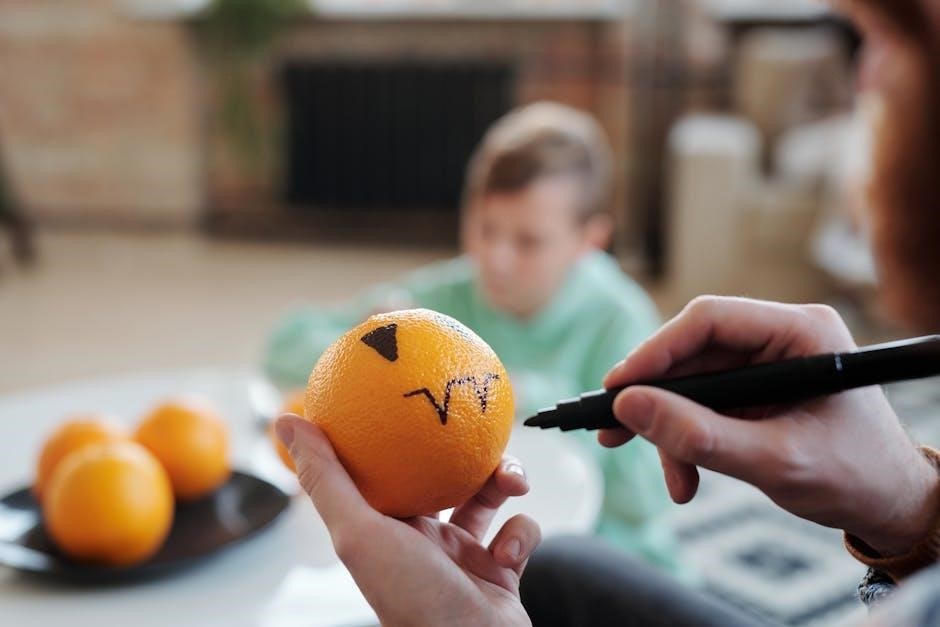The listen and draw activity is an engaging method for adults to enhance listening skills and creativity by following verbal instructions to create artwork, fostering focus and imagination.
1.1 Definition and Purpose of the Activity
The listen and draw activity is a structured exercise where adults follow verbal instructions to create specific drawings. It is designed to enhance listening skills, concentration, and creativity by requiring participants to translate spoken directions into visual representations. The purpose of this activity is to improve communication abilities, foster active listening, and encourage imaginative thinking. By focusing on clear instructions, adults develop their ability to interpret and execute tasks accurately. This method is particularly effective in educational and therapeutic settings, as it provides a fun and engaging way to practice language proficiency and artistic expression. The activity is adaptable to various skill levels, making it accessible to beginners and advanced participants alike. Its primary goal is to offer a creative outlet while strengthening essential cognitive and motor skills.
1.2 Importance of Listening Skills for Adults
Listening skills are essential for adults, as they play a critical role in effective communication, professional success, and personal relationships. The ability to listen attentively ensures understanding, reduces misunderstandings, and fosters collaboration. In both personal and professional settings, strong listening skills enhance problem-solving, decision-making, and conflict resolution. They also contribute to emotional intelligence, empathy, and trust-building. For adults, improving listening skills can lead to better job performance, stronger leadership, and more meaningful connections. In the context of the listen and draw activity, heightened listening abilities enable adults to follow complex instructions accurately, translating verbal descriptions into precise visual representations. This skill is vital for tasks requiring attention to detail and clear communication. By refining their listening skills, adults can navigate everyday challenges more effectively and achieve greater personal and professional fulfillment. Thus, listening is a cornerstone of effective interaction and lifelong learning.
1.3 How the Activity Enhances Creativity and Focus
The listen and draw activity is a powerful tool for enhancing both creativity and focus in adults. By translating verbal instructions into visual representations, participants engage their imagination, exploring new ways to interpret and express ideas. This process stimulates creative thinking, as adults must think outside the box to bring abstract descriptions to life. Simultaneously, the activity sharpens focus by requiring sustained attention to detail and the ability to follow complex sequences of instructions. As adults concentrate on capturing every element described, they develop greater mindfulness and concentration. Over time, these exercises can lead to improved problem-solving skills, as participants learn to break down tasks into manageable steps. The combination of creativity and focus fosters a sense of accomplishment and boosts self-confidence, making the activity both intellectually stimulating and personally rewarding. This dual enhancement makes it a valuable practice for personal growth and skill development.

Benefits of Listen and Draw Activities for Adults
Listen and draw activities enhance listening skills, creativity, and focus while improving communication and language proficiency. They also provide relaxation, reduce stress, and boost overall confidence and self-expression.
2;1 Improved Listening Skills and Concentration
Listen and draw activities significantly enhance listening skills and concentration in adults by requiring focused attention to verbal instructions. As participants follow directions to create specific images, they develop the ability to process and retain detailed information accurately. This method encourages active listening, reducing distractions and improving memory retention. By engaging both auditory and visual learning, adults refine their capacity to comprehend complex instructions and translate them into tangible outcomes. Regular practice leads to improved concentration, enabling better focus in personal and professional settings. The structured nature of these activities ensures consistent skill development, making them an effective tool for enhancing listening abilities and overall communication proficiency.
2.2 Enhanced Creativity and Problem-Solving Abilities
Listen and draw activities foster creativity and problem-solving skills in adults by encouraging them to interpret and visualize verbal instructions; As participants translate abstract descriptions into tangible drawings, they engage their imagination and critical thinking. This process stimulates creative expression, as adults must decide on colors, shapes, and details to bring their interpretation to life. Problem-solving abilities are enhanced as they navigate challenges, such as understanding ambiguous instructions or adapting their drawing to fit unexpected elements. The activity also promotes experimentation with different techniques, boosting confidence in artistic expression. By exploring various interpretations of the same instructions, adults develop a deeper understanding of diverse perspectives and creative approaches. This engaging method not only sharpens cognitive skills but also provides a fulfilling outlet for self-expression and innovation.
2.3 Better Communication and Language Proficiency

The listen and draw activity significantly enhances communication and language skills in adults by requiring precise interpretation and execution of verbal instructions. This method sharpens comprehension, as participants must accurately grasp and translate complex descriptions into visual representations. It also improves vocabulary retention, as adults are exposed to descriptive language and terminology related to art and design. For non-native speakers, this activity serves as an effective tool for practicing English proficiency, fostering both listening and speaking abilities. Furthermore, the collaborative nature of group settings encourages dialogue, helping adults articulate their creative processes and exchange ideas. By refining their ability to understand and convey ideas, adults develop stronger communication skills, making this activity a versatile and engaging way to enhance language proficiency while fostering creativity and collaboration.
2.4 Stress Relief and Relaxation
The listen and draw activity offers a therapeutic outlet for adults, providing a calming and relaxing experience. Engaging in creative tasks like drawing helps reduce stress by focusing the mind on the present moment, diverting attention from daily worries. The process of interpreting verbal instructions and translating them into visuals fosters mindfulness, allowing participants to unwind and recharge. Additionally, the satisfaction of creating something tangible boosts mood and confidence, further contributing to emotional well-being. This activity serves as a healthy escape from the pressures of work or personal life, promoting a sense of calm and fulfillment. By combining creativity with focused listening, it creates a meditative environment that encourages self-care and relaxation, making it an ideal way for adults to de-stress while engaging in a productive and enjoyable activity.

Setting Up the Listen and Draw Activity
Setting up the activity involves gathering materials like paper and drawing tools, selecting a quiet space, and preparing clear instructions for participants to ensure a smooth experience.

3.1 Materials Required for the Activity
The materials needed for a listen and draw activity are straightforward and easily accessible. Begin with blank paper, preferably A4 size, to provide ample drawing space. Pencils and erasers are essential tools for sketching and making corrections. Markers or colored pencils can be optional for those who wish to add color to their creations. A clear, well-lit workspace is also recommended to ensure visibility and comfort during the activity. For complex exercises, having visual aids or reference images can be helpful, though not mandatory. Ensure that all participants have their own set of materials to avoid sharing and maintain focus. These simple yet effective supplies create an environment where adults can engage fully in the activity, fostering creativity and concentration. Properly gathering these materials ensures a smooth and enjoyable experience for everyone involved.
3.2 Choosing the Right Environment for the Activity
Creating a conducive environment is crucial for the success of a listen and draw activity. Ensure the space is quiet and free from distractions to allow participants to focus on the instructions. A well-lit room with comfortable seating is essential for visibility and relaxation. Arrange the seating so that everyone can easily hear the instructor or audio source. A distraction-free zone minimizes interruptions, helping adults stay engaged. For group activities, consider the layout to encourage interaction and collaboration. A positive and calming atmosphere fosters creativity and reduces stress. Ensure all participants face the same direction or have a clear view of any visual aids used. By setting up an environment that promotes focus and comfort, adults can fully immerse themselves in the activity, maximizing their learning and creative experience. Properly arranging the space ensures the activity runs smoothly and effectively.
3.3 Preparing Clear and Concise Instructions
To ensure the success of the listen and draw activity, it is essential to prepare clear and concise instructions. Adults should be able to easily understand and follow the directions without confusion. Begin by breaking down the instructions into simple, manageable steps. Use plain language and avoid overly complex descriptions to accommodate all skill levels. Providing visual examples or demonstrations can also help clarify expectations. Ensure that each instruction is delivered at a steady pace, allowing participants to process and implement each step. Encourage questions to address any misunderstandings before proceeding. Clear instructions not only enhance the learning experience but also help adults stay focused and engaged. By organizing the instructions logically and delivering them calmly, you create a supportive environment that fosters creativity and effective listening. This approach ensures that participants can confidently follow along and enjoy the activity.

Conducting the Listen and Draw Activity

Conducting the activity involves guiding adults through verbal instructions, ensuring active participation, and maintaining engagement. Encourage creativity while keeping the atmosphere relaxed and focused.
4.1 Providing Verbal Instructions and Demonstrations
Providing clear verbal instructions is essential for guiding adults through the listen and draw activity. Start with simple, concise directions, such as “Draw a circle in the center of the page,” and gradually build complexity. Demonstrations are equally important, as they help adults visualize the expected outcome. For example, showing how to sketch basic shapes or objects ensures everyone understands the task. Use a calm and steady tone to deliver instructions, allowing participants to process the information without feeling rushed. Visual aids, like diagrams or examples, can complement verbal cues, especially for those who may need additional support. Encourage active listening by pausing between steps and asking if anyone needs clarification. This approach fosters a collaborative and productive environment, ensuring all participants can follow along and create their artwork confidently.
4.2 Encouraging Active Listening and Participation
Encouraging active listening and participation is vital for the success of the listen and draw activity. Begin by creating a distraction-free environment where adults can fully focus on the instructions. Encourage participants to maintain eye contact with the instructor and avoid side conversations. Use storytelling or descriptive language to make the instructions engaging and relatable. Pause occasionally to ask questions like, “What do you think the next step should be?” to ensure understanding and involvement. Positive reinforcement, such as praising creative interpretations, can boost confidence and motivation. Incorporate interactive elements, like group discussions or sharing drawings, to foster collaboration and camaraderie. Providing opportunities for feedback allows adults to refine their skills and feel valued. By making the activity inclusive and enjoyable, you can ensure high levels of participation and engagement.
4.3 Managing Time and Pacing the Activity
Effectively managing time and pacing is crucial for a smooth listen and draw activity. Begin by estimating the duration of each task based on complexity and participant skill levels. Use a timer to keep the activity on track and ensure all participants have enough time to complete their drawings. Provide clear time checkpoints, such as “You have five minutes left,” to help adults manage their progress. Break down complex instructions into smaller, manageable steps to maintain a steady pace. Encourage participants to work at their own speed, offering support to those who need it. Pause occasionally to check progress and address questions, ensuring no one feels rushed or left behind. Conclude the activity by allowing time for participants to share their drawings, fostering a sense of accomplishment and community. Proper time management ensures a balanced and enjoyable experience for all.

Simple Drawing Exercises for Adults
Simple drawing exercises introduce adults to basic shapes and objects, like drawing a house or tree, enhancing listening skills and creativity through clear, step-by-step verbal instructions.
5.1 Basic Shapes and Objects Drawing
This exercise involves drawing fundamental shapes like circles, squares, and triangles, progressing to simple objects such as houses or trees. Participants receive clear, step-by-step verbal instructions, enhancing their ability to follow directions accurately. The simplicity of these tasks makes them accessible to all skill levels, fostering a comfortable environment for beginners. By focusing on basic forms, adults improve their fine motor skills and hand-eye coordination while refining their listening abilities. These exercises serve as an excellent warm-up or icebreaker, encouraging creativity and engagement. They are ideal for language learners, as they promote active listening and comprehension. Over time, mastering these foundational skills builds confidence and prepares participants for more complex drawing challenges. This approach ensures a smooth transition into advanced activities, making it a cornerstone of the listen-and-draw experience.
5.2 Step-by-Step Instructions for Simple Images
This exercise involves providing adults with detailed, sequential instructions to create simple yet cohesive images. For example, participants might be guided to draw a sun by first creating a circle, then adding rays extending outward. Each step is explained clearly, ensuring clarity and ease of execution. This method helps adults focus on individual elements, making the task less overwhelming. The process enhances listening skills as participants must pay close attention to each instruction. Starting with simple images, such as a cat or a tree, allows adults to build confidence gradually; As they progress, the complexity of the images can increase, introducing more details like colors or textures. This structured approach fosters creativity and precision, making it an effective way to improve both artistic and listening abilities. The step-by-step format ensures everyone stays engaged and motivated throughout the activity.
5.3 Warm-Up Activities to Engage Participants
Warm-up activities are essential to get adults ready for listen and draw exercises. These activities help participants relax and focus. One common warm-up is a quick drawing game where adults sketch simple shapes or objects based on brief instructions, like “draw a circle” or “add a line.” This helps loosen up their hands and minds. Another activity involves listening to a short story or descriptive paragraph, then drawing whatever comes to mind. This sparks imagination and gets participants in the right mindset. Group exercises, like passing a paper around and adding to each other’s drawings, also encourage collaboration and creativity. These warm-ups are designed to be fun and stress-free, making it easier for adults to engage fully in the main activity. Starting with these exercises ensures participants are prepared and excited to take on more complex challenges. This approach fosters a positive and productive environment for learning and creativity.

Complex Drawing Exercises for Adults
Complex drawing exercises challenge adults with intricate steps and detailed verbal instructions, fostering advanced listening skills, creativity, and problem-solving abilities through artistic expression.
6.1 Drawing Scenes with Multiple Elements
Drawing scenes with multiple elements is a challenging yet rewarding exercise for adults in listen and draw activities. This involves creating intricate compositions, such as landscapes, cityscapes, or narrative scenes, based on detailed verbal instructions. Participants must carefully listen to descriptions of various components, including characters, objects, and settings, and translate them into a cohesive visual representation. This exercise enhances listening accuracy and memory, as adults need to retain and organize multiple details. It also sharpens problem-solving skills, as they must decide how to arrange elements to achieve balance and harmony. Additionally, drawing scenes with multiple elements encourages creativity, allowing adults to interpret instructions in their unique style. The complexity of these exercises makes them ideal for advanced learners, fostering artistic expression and critical thinking. This activity can be adapted to different themes and skill levels, making it versatile for various educational or therapeutic settings.

6.2 Incorporating Details and Complex Instructions
Incorporating details and complex instructions into listen and draw activities challenges adults to refine their listening and artistic skills. This involves providing intricate verbal descriptions, such as specific shapes, colors, and spatial relationships, for participants to translate into detailed drawings. Complex instructions may include layering elements, adding textures, or creating depth through perspective. Adults must focus intensely to capture every detail, enhancing their ability to follow multi-step directions. This exercise also fosters creativity, as participants interpret complex descriptions in their unique artistic style. The inclusion of subtle details encourages precision and patience, while the complexity of the instructions sharpens problem-solving abilities. By mastering these challenging tasks, adults can improve their critical thinking and artistic expression, making this activity both intellectually stimulating and artistically rewarding. It is an excellent way to push participants beyond basic drawing exercises and explore advanced techniques;
6.3 Advanced Techniques for Artistic Expression
Advanced techniques in listen and draw activities for adults introduce sophisticated artistic elements, such as shading, perspective, and layering, to elevate their creative expression. Participants are guided through verbal instructions to explore complex artistic styles, like realism or abstraction, enhancing their ability to interpret and execute intricate designs. These techniques encourage adults to experiment with proportions, textures, and depth, refining their drawing skills. By incorporating advanced methods, the activity challenges adults to think critically and aesthetically, translating detailed verbal descriptions into visually compelling artwork. This level of instruction not only improves listening accuracy but also fosters a deeper appreciation for art and creativity. Adults can explore various artistic movements or themes, making the activity both educational and engaging. Through advanced techniques, participants gain confidence in their artistic abilities while honing their listening and interpretive skills.
The listen and draw activity is a dynamic tool for adults, enhancing listening, creativity, and focus while offering relaxation and fostering artistic expression through guided, imaginative exercises.
7.1 Summary of Key Benefits for Adults
The listen and draw activity offers numerous benefits for adults, including enhanced listening skills, improved focus, and boosted creativity. It provides a unique opportunity for adults to practice active listening while expressing their imagination through art. This activity also serves as a stress-relief mechanism, allowing participants to unwind and relax. Additionally, it fosters effective communication and language proficiency, making it ideal for language learners. The ability to follow complex instructions and translate them into visual representations sharpens critical thinking and problem-solving abilities. Overall, the activity is a versatile and engaging tool that can be adapted to various settings, from educational environments to therapeutic sessions. By combining auditory and visual learning, it creates a holistic experience that promotes personal growth and artistic expression. This makes it a valuable and enjoyable activity for adults seeking to enhance their skills in a creative and relaxing manner.
7.2 Encouraging Continuous Practice and Improvement
To maximize the benefits of the listen and draw activity, consistent practice is essential; Encouraging adults to engage in regular sessions helps refine their listening skills and artistic abilities. Setting achievable goals, such as completing a drawing based on detailed instructions, can motivate participants to improve steadily. Providing constructive feedback and celebrating progress, no matter how small, fosters a supportive environment. Incorporating a variety of exercises, from simple shapes to complex scenes, keeps the activity engaging and challenging. Adults can also explore different techniques and tools to enhance their creativity. By making the activity a routine part of their schedule, adults can develop a lifelong skill that combines auditory processing with artistic expression. This consistent practice not only enhances their abilities but also builds confidence and a sense of accomplishment. Regular participation ensures continuous growth and enjoyment in the activity.
7.3 Adapting the Activity for Different Settings
The listen and draw activity can be easily adapted to suit various environments, making it versatile for different groups and purposes. In educational settings, it can be integrated into language or art classes to enhance listening and creativity. For corporate teams, it can serve as a bonding exercise, fostering communication and collaboration. In therapeutic contexts, the activity can be used to promote relaxation and self-expression. Adjusting the complexity of instructions and materials allows the activity to cater to diverse skill levels and preferences. For example, simpler exercises can be used with beginners, while more detailed tasks can challenge advanced participants. Additionally, incorporating themes or cultural elements can make the activity more engaging and relevant to specific audiences. This adaptability ensures the listen and draw activity remains effective and enjoyable across different settings, making it a valuable tool for personal and professional development.
